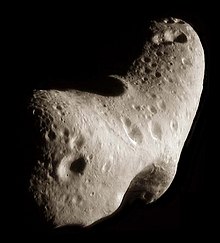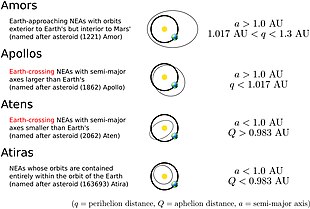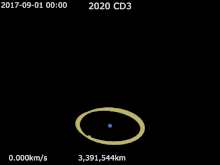Near-Earth object
[30][31] PHAs are defined based on two parameters relating to respectively their potential to approach the Earth dangerously closely and the estimated consequences that an impact would have if it occurs.[2] Objects with both an Earth minimum orbit intersection distance (MOID) of 0.05 AU or less and an absolute magnitude of 22.0 or brighter (a rough indicator of large size) are considered PHAs.[35] The asteroid was subject to several extensive observation campaigns, primarily because measurements of its orbit enabled a precise determination of the then imperfectly known distance of the Earth from the Sun.[37] Orbital calculations show that P/1999 J6 (SOHO), a faint sungrazing comet and confirmed short-period NEC observed only during its close approaches to the Sun,[38] passed Earth undetected at a distance of 0.0120 AU (4.65 LD) on June 12, 1999.[49] On February 15, 2013, the 30 m (98 ft) asteroid 367943 Duende (2012 DA14) passed approximately 27,700 km (17,200 mi) above the surface of Earth, closer than satellites in geosynchronous orbit.On August 10, 1972, a meteor that became known as the 1972 Great Daylight Fireball was witnessed by many people and even filmed as it moved north over the Rocky Mountains from the U.S. Southwest to Canada.[57] The second-largest observed event after the Tunguska meteor was a 1.1 megaton air blast in 1963 near the Prince Edward Islands between South Africa and Antarctica.Dust-sized NEOs have impacted man-made spacecraft, including the space probe Long Duration Exposure Facility, which collected interplanetary dust in low Earth orbit for six years from 1984.[81] The National Aeronautics and Space Administration NASA maintains an automated system to evaluate the threat from known NEOs over the next 100 years, which generates the continuously updated Sentry Risk Table.It was rediscovered in December 2000 prior to a close approach the next year, when new observations, including radar imaging, allowed much more precise orbit calculations.[91] As observations were collected over the next three days, the calculated chance of impact first increased to as high as 2.7%,[92] then fell back to zero, as the shrinking uncertainty zone for this close approach no longer included the Earth.[82] Astronomers responded by scheduling observations with more powerful telescopes as the objects recedes and gets dimmer, to determine its orbit with more precision and thus improve the impact risk prediction.[97] Project Icarus received wide media coverage, and inspired the 1979 disaster movie Meteor, in which the US and the USSR join forces to blow up an Earth-bound fragment of an asteroid hit by a comet.[7] In 1998, the United States Congress gave NASA a mandate to detect 90% of near-Earth asteroids over 1 km (0.62 mi) diameter (that threaten global devastation) by 2008.[1] In 2005, the original USA Spaceguard mandate was extended by the George E. Brown, Jr. Near-Earth Object Survey Act, which calls for NASA to detect 90% of NEOs with diameters of 140 m (460 ft) or greater, by 2020.[108] Another project, the Zwicky Transient Facility (ZTF), which surveys for objects that change their brightness rapidly,[109] also detects asteroids passing close to Earth.[13] Deflection, which means a change in the object's orbit months to years prior to the predicted impact, also requires orders of magnitude less energy.[13] When an NEO is detected, like all other small Solar System bodies, its positions and brightness are submitted to the (IAU's) Minor Planet Center (MPC) for cataloging.[30] NEOs are also catalogued by two separate units of the Jet Propulsion Laboratory (JPL) of NASA: the Center for Near Earth Object Studies (CNEOS)[113] and the Solar System Dynamics Group.[122] In the year 2000 and taking into account all known observational biases, it was estimated that there are approximately 900 near-Earth asteroids of at least kilometer size, or technically and more accurately, with an absolute magnitude brighter than 17.75.[127] In May 2022, an algorithm known as Tracklet-less Heliocentric Orbit Recovery or THOR and developed by University of Washington researchers to discover asteroids in the solar system was announced as a success.[134] In 2017, two studies using an improved statistical method reduced the estimated number of NEAs brighter than absolute magnitude 17.75 (approximately over one kilometer in diameter) slightly to 921±20.[67] As the distinction began to blur with the discovery of ever smaller asteroids and a greater variety of observed NEO impacts, revised definitions with size limits have been proposed from the 1990s.Examples of such artificial near-Earth objects include a Tesla Roadster used as dummy payload in a 2018 rocket test[169] and the Kepler space telescope.During its 2007 flyby of Earth on its route to a comet, ESA's space probe Rosetta was detected unidentified and classified as asteroid 2007 VN84, with an alert issued due to its close approach.They may present interesting scientific opportunities both for direct geochemical and astronomical investigation, and as potentially economical sources of extraterrestrial materials for human exploitation.[16] A second NEA, the 535 m (1,755 ft) long peanut-shaped 25143 Itokawa, was explored from September 2005 to April 2007 by JAXA's Hayabusa mission, which succeeded in taking material samples back to Earth.[21] A second sample-return mission, NASA's OSIRIS-REx probe, targeted the 500 m (1,600 ft) Apollo asteroid 101955 Bennu,[181] which, as of January 2025[update], has the third-highest cumulative Palermo scale rating (−1.40 for several close encounters between 2178 and 2290).[184] In 2025, JAXA plans to launch another probe, DESTINY+, to explore Apollo asteroid 3200 Phaethon, the parent body of the Geminid meteor shower, during a flyby.[185] On September 26, 2022, NASA's DART spacecraft reached the system of 65803 Didymos and impacted the Apollo asteroid's moon Dimorphos, in a test of a method of planetary defense against near-Earth objects.







Asteroids discovered in the first three years of the
Near-Earth Object WISE
program, starting in December 2013, with green dots showing NEAs







2020 CD 3 · Moon · Earth






(388188) 2006 DP142009 FD103P/HartleyDeep ImpactSmall Solar System bodyApollosCometsAtirasperihelionastronomical unitpotentially hazardous objectasteroidsmeteoroidstsunamisAsteroid impact avoidanceTorino scalePalermo scaleSpaceguardasteroid miningpotentially hazardous asteroidsInternational Astronomical Unionsmall Solar System bodiesastronomical unitsplanetsnatural satellitesasteroidpotentially hazardous objectsminimum orbit intersection distancealbedoHalley's Comet433 ErosNEAR ShoemakerTycho BraheparallaxEdmond HalleymeteorsLeonid meteor showerDenison Olmsted55P/Tempel–TuttleList of asteroid close approaches to Earth73P/Schwassmann–WachmannLexell's CometComet Tempel–TuttleP/1999 J6 (SOHO)sungrazing comet69230 Hermesdistance of the Moon1566 Icarus1991 BA2020 VT4(308635) 2005 YU55lunar distances367943 DuendeEarth-grazing fireball1972 Great Daylight FireballRocky MountainsEarth-grazing meteoroid EN131090European Fireball NetworkImpact eventList of predicted asteroid impacts on Earthupper atmospherevaporizedtsunamiimpact cratersasteroid main beltHiroshimamegatonsTunguska eventPrince Edward Islandsinfrasoundnuclear testChelyabinsk meteor2011 EO402023 CX12008 TC3Nubian DesertmeteorComprehensive Nuclear-Test-Ban Treaty OrganizationAsteroid impact predictionLong Duration Exposure Facilityinterplanetary dust4179 Toutatisculturetechnologyhuman societyextinctionNoah's floodperceptionCretaceous–Paleogene extinction eventlarge asteroid impact4581 Asclepiusmegatons of TNTComet Shoemaker–Levy 9(35396) 1997 XF11Armageddonconspiracy theoryNibiru1997 XF11Palermo Technical Impact Hazard ScalelogarithmSentry Risk TableNEODySEuropean Space Agency(163132) 2002 CU11(29075) 1950 DA99942 Apophis2010 RF12potentially hazardous asteroid2024 YR4Massachusetts Institute of TechnologyPalomar Planet-Crossing Asteroid SurveyinterdisciplinarySnowmass, ColoradoUnited States CongressVulcanoThe Spaceguard FoundationsurveysLincoln Near-Earth Asteroid ResearchSpacewatchNear-Earth Asteroid TrackingLowell Observatory Near-Earth-Object SearchCatalina Sky SurveyCampo Imperatore Near-Earth Object SurveyJapanese Spaceguard AssociationAsiago-DLR Asteroid SurveyGeorge E. Brown, Jr.
